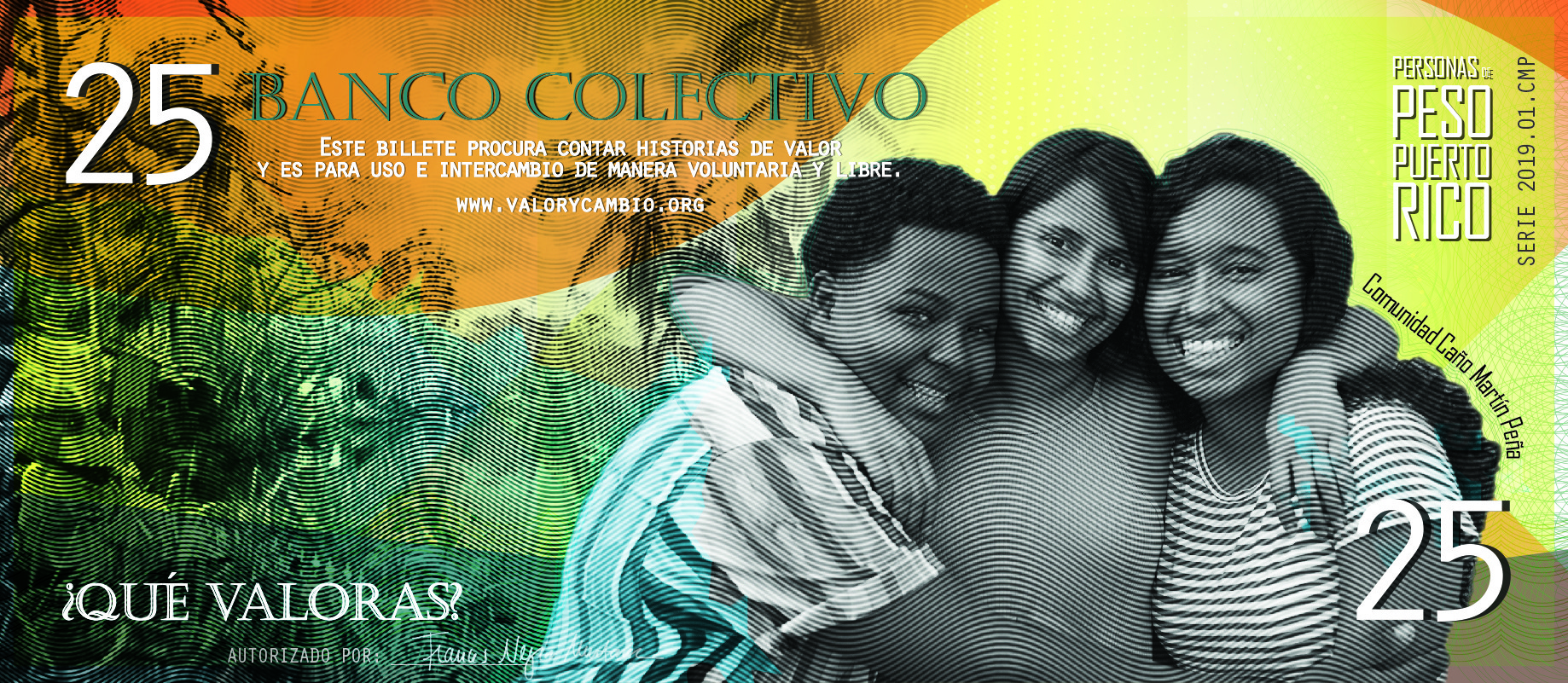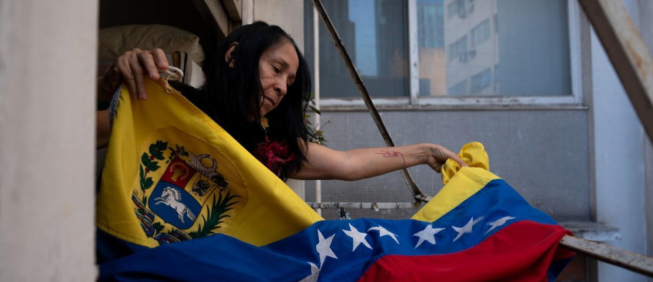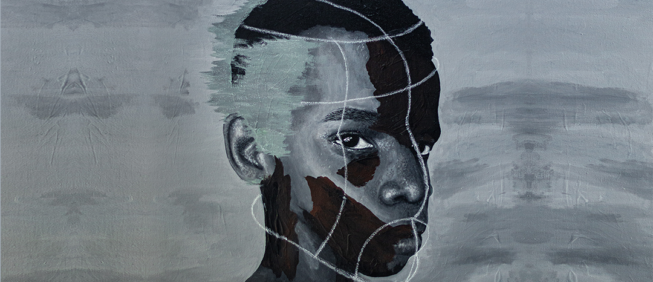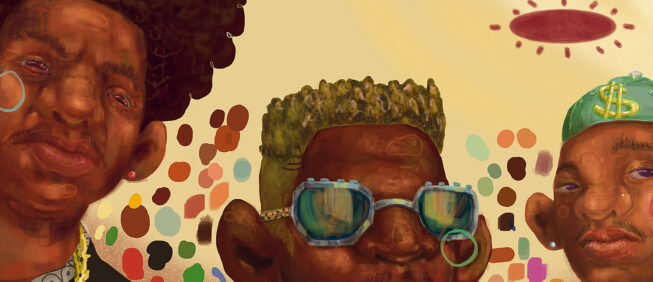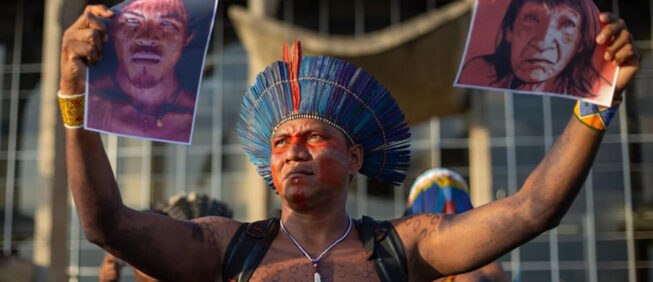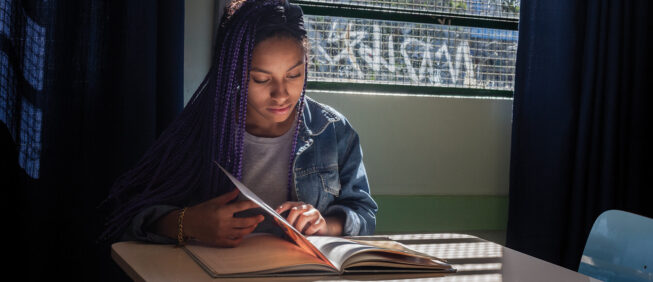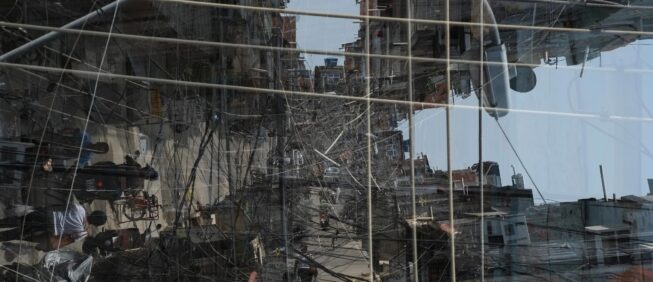Decolonizing money in puerto rico
The Valor y Cambio Project
Frances Negrón-Muntane
| Puerto Rico |
21 de July de 2019
Since 2006, Puerto Rico has been enduring a debt crisis that reached over 127 billion and resulted in increased poverty rates, mass migration, and cuts to essential public services. In response, the scholar and artist Frances Negrón-Muntaner collaborated with artist Sarabel Santos Negrón to launch the community currency project Valor y Cambio (Value and Change). The project is both an investigation about what residents of Puerto Rico, and the Puerto Rican diaspora value, and a way to rethink the very notion of “economy”and its political dimensions. In the light of the massive protests in the streets of Puerto Rico this July, the project has proven prophetic.
Negrón-Muntaner, who is also a curator, filmmaker, and professor at Columbia University, explains the initiative’s first phase that ran from February 8-17 in Puerto Rico. The project is now on tour in New York City through the fall.
What is “Value and Change”?
Value and Change is an interactive storytelling and community currency project that seeks to challenge austerity policies in Puerto Rico and beyond though investigating what participants value, and introducing a community currency, Personas de Pesos Puerto Rico or pesos for short, as a way to share valuable stories and practice exchange-base economies.
To set the project in motion, we designed an initial series of six “banknotes” that ranged from one to 25 pesos and featured images of Puerto Rican historical figures and an iconic community. We also reconfigured an ATM bank machine that we named VyC (acronym of Value and Change) to record people’s stories and dispense the project’s bills. To obtain a bill, the VyC asked participants to tell us about what they valued, how their communities can support what they value, and what people or groups are already sustaining these values. Participants could then exchange the bill for items at businesses and organizations located in several neighborhoods and cities, including San Juan, Caño Martín Peña, Bayamón, Rio Piedras, Cupey, Miramar, Humacao, and later, New York.
In general, the project aims to faciliitate a conversation about what we call the "economy". On the one hand, we are questioning the idea that the resources of a community should be used to promote the success of individuals instead of collective well-being. On the other hand, we want to emphasize that the “economy” is not only about production or work, but also about subjectivities, political possibilities, and how people relate to each other.
What is a community currency?
A community or complementary currency is one that communities, industries, or groups create to meet their particular exchange needs. Community currencies vary greatly: they can be organized as time banks where the unit of value and exchange is time, or supported by national currencies. In general, they do not replace the national or main currency, but offer ways to strengthen local activity and build solidarity economies that are not based on profit and accumulation. There are numerous community currencies circulating around the world, in Spain alone there are approximately 300.
Our initiative also views the use of community currencies as a challenge to the idea that communities, groups, or people with little access to the formal or dominant economy are inherently poor. While not having employment in that economy may mean less access to basic products and services, many communities called "poor" can be rich in how they build relationships, in addition to having resources and competencies in multiple areas such as engineering, healthcare, agriculture, and the arts. Community currencies can value and facilitate the exchange of these talents and knowledge for the benefit of communities and regions.
Moreover, in a captive market like Puerto Rico, where US and transnational for profit companies dominate and extract enormous wealth, community currencies can have an additional impact. As the bills would only circulate in Puerto Rico and the diaspora, they can support local economies instead of enriching large corporations. This is the way they are used in places like Bristol in England and in Fortaleza, Brazil. In addition, community currencies open the possibility for residents to develop their own monetary policies and thus collectively recognize and validate what they value.
I see great potential in using community currencies to value and support the unrecognized work of care and reproduction of life that women generally perform, and as a way to incorporate older people and other members of the community who have so much to offer, but in the current economy they are perceived and treated as "surplus".
"The project aims to facilitate a conversation about what we call the "economy". On the one hand, we are questioning the idea that the resources of a community should be used to promote the success of individuals instead of collective well-being. On the other hand, we want to emphasize that the “economy” is not only about production or work, but also about subjectivities, political possibilities, and how people relate to each other."
How did Value and Change begin?
For me, it was a combination of revelations, questions, and discoveries. One happened last year when Vanessa Pérez-Rosario, editor of Small Axe interviewed me about the work I was doing as part of Unpayable Debt,a research group on global debt that I co-direct at Columbia University (New York). For three years, the group devoted itself to studying the economic crisis of the island in a global and comparative context. The process made me think of a concept I had not dedicated much time to before: money. What is money? How do you acquire value? How can money be a strategy to reconfigure the prevailing economy? I understood that while money in itself is "nothing," it can also tell stories, reconstitute human relationships, and be part of political change.
A second revelation emerged when reading about how, in 2013, while Ireland continued to deal with the economic crisis of 2008, the government promoted a conversation about what people value in order to develop new curricula and inform policy. I realized that this public conversation had not occurred in Puerto Rico, but it seemed very urgent to have it there.
The third had to do with art. From the beginning, our working group identified the arts as one of the key practices to imagine and share other ways of thinking and acting in the face of austerity crises, and I also noticed that solidarity economy projects are frequently initiated by artists. With this in mind, last year I organized an exhibition called Puerto Rico Under Water: Artistic Perspectives on the Debt Crisisin the Gallery of the Center for the Study of Ethnicity and Race at Columbia University. The curatorial process confirmed to me that artists were performing important work in investigating the affects of debt, enabling different social relationships, and challenging dominant discourses. Equally significant, the process made me more familiar with the work of Sarabel Santos Negrón, one of the exhibition's artists, who produced a series of photographs documenting what I would call the "debris" of the debt crisis. After the exhibition, I approached Sarabel and told her about the idea of the currency. She immediately agreed to collaborate and we began to work on the design of the bills.
The fact that the figures are historical also allowed us to suggest that although the challenges of today are formidable, the country has faced challenges at all times in its history and there is a great amount of knowledge, debates, and perspectives on them. In this sense, the value of remembering stories is not only to highlight what people "did" but to reflect on the ways in which these struggles and thoughts can inform the present.
"I see great potential in using community currencies to value and support the unrecognized work of care and reproduction of life that women generally perform, and as a way to incorporate older people and other members of the community who have so much to offer, but in the current economy they are perceived and treated as "surplus".
The bills are beautiful. How did the design come about?
Sarabel and I studied national, social, and artistic currencies from around the world. In this process we saw the great potential of currency to tell different stories and circulate other values. We also conducted an informal survey of people living in Puerto Rico and in the diaspora. We asked what figures, communities or places embody the values we had identified as fundamental to the project – equity, justice, solidarity and creativity – and likewise allowed us to discuss current critical issues such as public education and access to healthcare, clean environment, self-government, food security, just distribution of wealth, and racial and gender equity.
It was difficult to select only six stories from the resulting list. In the end we chose figures from the past and communities of the present, who have acted according to shared values that have enriched the lives of others. They are (generally in order of birth): the siblings Gregoria, Celestina and Rafael Cordero; Ramón Emeterio Betances, Luisa Capetillo, Julia de Burgos, Roberto Clemente and the eight communities of the Caño Martín Peña, an urban neighborhood of 25,000 people adjacent to San Juan’s banking district. Another part of the design was that we inserted a QR code on the back of the bills. This element is an integral part of the exchanges that the project sets in motion: In exchange for telling us what they value, the code directs the participants to our website to get more information about the figures and communities that we value.
"The fact that the figures are historical also allowed us to suggest that although the challenges of today are formidable, the country has faced challenges at all times in its history and there is a great amount of knowledge, debates, and perspectives on them. In this sense, the value of remembering stories is not only to highlight what people "did" but to reflect on the ways in which these struggles and thoughts can inform the present."
Why not design a virtual currency?
Despite being in the era of digital and speculative currency, like BitCoin, we chose a paper currency that can be passed from hand to hand. We thought that this could be used to start conversations and facilitate the creation of new collective visions. And that's what happened. Project participants sometimes exchanged or compared notes while waiting in line, and shared ideas and aspirations. This does not mean that I consider that community currencies "must" be in paper. There are virtual one such as the Ossetana of Andalucia. As everything that has to do with community currencies, its design and mode of circulation must be related to the needs of users.
How many bills circulated?
In the nine days of the project in Puerto Rico, approximately 1600 bills of all denominations circulated. To avoid overwhelming the participating small businesses we limited the circulation of the 21 and 25 bills. But eventually we saw that this precaution was not necessary. We found that most people wanted to keep the bills instead of exchanging them for products or services. For some participants, what the bill represented far exceeded its exchange value.
Why do you think this happened?
We will be reflecting more on this in the months to come but my sense so far is that people kept the bills in order to value themselves and their communities. And we can contextualize that response in various ways. One is that the currency used in Puerto Rico is not simply that of another country, but of a colonizing nation-state that also only includes figures of men who identify themselves as white, representatives of the state, and / or holders of racist genocidal, or heterosexist policies. The idea of a currency that circulates images and stories of women, blacks, Puerto Ricans; migrants and children of immigrants; writers, doctors, educators, athletes, thinkers, feminists, union organizers; individuals as well as families and communities; affirmed that there are other ways to count and to value. And the project did it using one of the most powerful signifiers of US colonialism in Puerto Rico: money.
I also think that for some people, the bills meant the possibility of a more just, inclusive and equitable Puerto Rico in the present. Therefore, to the extent that this stage of the project lasted only a few days and there was doubt that it would be extended, most people chose to keep the bills as a symbol. If money is a "promise" of payment and the body that imposes austerity in Puerto Rico was created by a law called PROMESA, the bills represented a very different kind of promise.
What is the next step of Value and Change?
The next phase is to share what we learned from the process and from the responses. We will mainly do this in three ways: with a report about the content of the recordings, with a documentary video about the project’s trajectory, and with other public activities, such as conversations or talks in different fora. We are also very aware that many people on the island have not been able to participate and want to take part, especially outside the San Juan metro area. We are currently thinking on how to achieve this goal.
How have you measured the success of the project?
Talking about success is difficult because the effects may take a long time to manifest or may not be what we imagine or assume. But, measured by the values and immediate objectives of the project, one could say that Valor y Cambio was fruitful from the first conversation as nearly everyone wanted to participate, even if it entailed the possibility of “losing” money and “wasting” time. And though the project’s first phase only lasted nine days on the ground, thousands of people participated directly, online, and in mainstream media platforms.As a result, in a short period of time, thr project broadened the conversation about solidarity economies and present the idea of a community currency and its possible uses in Puerto Rico.
Moreover, almost immediately that the project went live, I started working with four communities that are considering adopting their own currency and developing networked exchange economies on the island and several U.S. cities. One of these communities will actually be launching their currency shortly in Puerto Rico. In addition, only three months after project began, several organizations invited Valor y Cambio to engage Puerto Rican and other communities in New York.
The project similarly circulated a certain joy or what I'm calling in an upcoming essay "decolonial joy," which I define as an emotion of varying duration that results when people can glimpse and feel the possibility of a different future where neither colonialism nor coloniality dominate their lives. This suggests that, contrary to the deeply held belief that Puerto Ricans and other island residents are apathetic, politically passive, or lack a collective vision, there is in many a deep hunger for a different society, and ways for people to relate otherwise.
In this, Valor y Cambio showed that not only other worlds are possible, but that we can live them every day, including through relatively small gestures such as imagining a currency, sharing a story, and valuing each other.
Yes. Although I do not know yet if the Valor y Cambio experience directly motivated a large number of people to join the protests or become politically active, one could say that the protests demonstrated several ways to perform what “value and change” can mean.
Originally published in Spanish in 80grados
